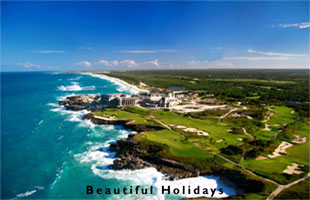Greater Antilles Holidays
The Caribbean

The Greater Antilles is an island group in the Caribbean made up of the nations of Cuba, Haiti & the Dominican Republic, Jamaica, and Puerto Rico. With all the big islands, the Greater Antilles constitutes almost 90% of the land mass of the entire West Indies. The islands of the Greater Antilles are all continental rock—geologically part of North America—as opposed to the islands that make up the Lesser Antilles, which are mostly young volcanic or coral islands.

Map of Greater Antilles
Greater Antilles Holidays Guide
The Republic of Cuba is the largest (110,860 km2) and most populous island nation in the Caribbean. It is a place of incredible natural beauty, with magnificent mountain ranges, flat fertile plains where sugar cane and tobacco remain the principal crops, and some of the most strikingly beautiful beaches in the world. It is a vibrant island with excellent resorts and beaches and the distinct advantage of being just a little rough around the edges when it comes to tourism, which is actually a good thing – you see the ‘real’ Cuba at all times, not a polished-for-guests facsimile.
The island of Hispaniola in the Caribbean is part of the Greater Antilles, and is shared by The Dominican Republic (DR), with two-thirds of the eastern side of the island, and Haiti, which occupies the western third. By both area and population the Dominican Republic is the second largest country in the Caribbean. It is here you will find the city of Santo Domingo, the first permanent European settlement in the Americas, as well as the country's capital and Spain's first capital in the New World.
The mountainous region is the location of the Caribbean's highest mountain, Pico Duarte, and the Caribbean's largest lake and lowest elevation, Lake Enriquillo. It is also famous for its whale watching -tens of thousands of marine lovers and eco-tourists flock to the small DR Municipality of Samaná between mid-January and mid-March, following the migration of the North Atlantic humpback whale. Although a popular Caribbean destination, and despite the striking terrain, coral cliffs, beaches and old Spanish towns, and many tourists from around the world, the islands unspoiled natural beauty remains largely unexplored. They call the north coast of the DR the Amber coast, for the numerous amber fossils found there, and the southern coast the coconut coast, as it is the more tropical, well-known for its all-inclusive hotels and resorts and more than a million visitors annually.
Jamaica is the third largest island in the Caribbean and home to Kingston Harbour, the seventh largest natural harbour in the world. Jamaica is the third most populated English-speaking country in the Americas, following only the United States and Canada. Though small, Jamaica has a solid global presence, famous for jerk spice, Blue Stripe beer, Blue Mountain coffee, and music. Reggae, ska, mento, rocksteady, dub, dancehall, and ragga all originated in this vibrant recording centre. Idyllic Jamaica is a nature-lover’s paradise. About 200 species of orchids grow wild all over the island, 73 of which are found nowhere else in the world. There are 500 species of fern, 1,000 species of trees, more than 252 species of birds, of which 27 are found only in Jamaica, including the streamer-tailed Hummingbird, or Doctor Bird, the national bird. Experience the exciting staircase of cascading waters at Dunns River Falls in Ocho Rios; explore the extensive shopping and resort possibilities in Montego Bay; visit old plantation homes in and around Negril, and spend some quality time on the unspoiled sands of Treasure Beach.
The lonely Cayman Islands, a British Territory in the western Caribbean, is located between Jamaica and Mexico's Yucatan Peninsula. The small island group consists of Grand Cayman (197 sq. km), Cayman Brac (36 sq. km), and Little Cayman (25.9 sq. km), all three of which are actually the tips of large, mostly flat coral heads covering submerged ice age mountains. The Caymans' beaches are rated as amongst the best in the world. A visitor favorite is Seven Mile Beach on Grand Cayman's western shore. World renowned for its beauty, the beach was named "The Caribbean's Best Beach" by Caribbean Travel and Life Magazine. As the most popular beach, it is also the most developed and commercialized area of Grand Cayman and is home to the majority of the island's luxury resorts and hotels. Rum Point on the north side of Grand Cayman offers tranquility, calm shallow waters, huts, hammocks, beach volleyball and all watersports—an ideal Cayman day. Heritage Beach, a remote spot found just past the East End Public dock, is a great place to get away for it all. A bit farther along is East End Public Beach, so secluded all you hear is the sound of lapping waves and singing birds, offers total seclusion and peace.
Puerto Rico is mostly mountainous with large coastal areas in the north and south. It boasts three magical bioluminescent bays and an amazing ancient underground cave system, among othe r natural wonders. In fact, the island is popularly known as "The Island of Enchantment." It is considered the culinary capital of the Caribbean for its incredible array of world-class restaurants and chefs, is a haven for shoppers with a fabulous selection of shopping venues, and has a nightlife that sizzles with excitement. There is enough to do in Puerto Rico to keep every member of your family or group happy. Five words: Golf, horses, bicycles, marathons, and surfing. If that’s not enough, try caving, shopping, tennis, boating, sailing, wind-surfing, attending a cock-fight, hiking, fishing, or camping.



